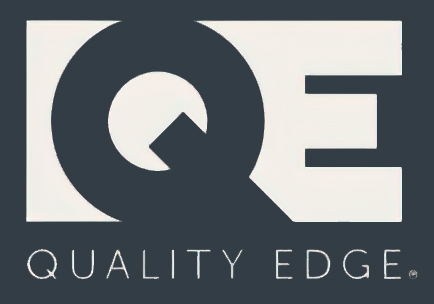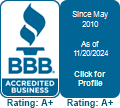The Science of Soffit Ventilation
70%
it’s estimated that 70% of homes don’t meet basic ventilation requirements
Research shows “most homes don’t meet basic ventilation requirements and are in violation of residential building codes” and, “approximately half of all U.S. homes have evidence of improper ventilation.” The Lawrence Berkley Laboratory states “poorly ventilated homes have been reported to be one of the leading causes of moisture build up, mold, mildew and rot in attics; which has contributed to alarming rise of many illnesses, including; asthma, allergies and other respiratory issues.”
Overheated. Dangerous. Damaging Air.
In order to have a balanced system you need more intake than exhaust
02 | Proper Ventilation
In order to prevent attic air from overheating, pressurizing and drawing into the home, there must be equal amounts (or more) air entering through soffits than exiting through roof vent systems. The U.S. Department of Energy recommends using a continuous roof ventilation system at the rooftop, and a continuous vented soffit system that provides more intake or net free area (NFA) at the eave edge than what is offered through the roof vent system. The problem is that most soffit panels today don’t offer enough NFA to work with the amount of roof ventilation required for the majority of homes.
Building Code
03 | Power of Proper Ventilation
Continuous Soffit and Ridge Vent
The Department of Energy and Habitat for Humanity states that “a combination of continuous ridge vent along the peak of the roof and continuous soffit vents at the eaves provides the most effective ventilation.”
1/150 Rule
The National Roofing Contractors Association recommends a minimum area of ventilation openings that is 1/150 fraction of the area of space ventilated. “Natural convection is responsible for initiating the upward flow of air though an attic. This air current can be maintained to aid in continuous circulation of air though the attic if intake vents placed low in the attic make colder air available to replace the heated air exhausted thought vents placed high in the attic.”
Balanced Attic
“The international building code Sec. 1203.2 states, “The net free ventilating area shall not be less than 1/150 of the area of the space ventilated, with 50 percent of the required ventilating area provided by ventilators located in the upper portion of the space to be ventilated at least 3 feet (914 mm) above eave or cornice vents with the balance of the required ventilation provided by eave or cornice vents.”
1/150 Rule Equation:
Sq. Ft. of attic = (a) ____________
Sq. Ft. of Code Required: (a)/150= (b) ____________
Sq. In of Code-Required 144 x (b) = (c) ____________
Sq. In NFA Needed Intake: (c)/2 = _____________
Outtake (c)/2 = ____________
Proper ventilation can reduce the temperature in your attic by
50
Degrees
04 | Power of Proper Ventilation
Proper ventilation (more in-take through soffits than exhaust through roof vents) according to the U.S. Department of Energy “can lower the attic temperature by as much as 50°f, which significantly reduces the home’s heating and cooling, demands.” Just because a soffit product has vents doesn’t mean it works! Typical one foot soffit overhangs should have at least an 11 NFA, so when used on both sides of the home will have a combined NFA of 22 to draw the air flow needed to work with a ridge vent system.
Energy Costs
Experience $4,300 in energy savings over the life of a 15 year mortgage
Summer Assumption
– 2,000 sq ft attic
– 21 NFA vs 2
– Outside temp 95°
– Roof temp 175°
– Inside temp 65°
– .11$/kWh
Winter Assumption
– 2,000 sq ft attic
– 20 R-Value vs 10 R-Value
– Outside temp 30°
– Inside temp 70°
– 80% Furnace rating
– .77 gas cost $/ccf
05 | Energy Costs
Residential Building Code requires proper ventilation through soffit systems that offers more net free area (NFA) for air flow, creating the updraft required to get air to exit through the ridge vents. Disher Engineering has estimated energy savings on a 2,000 square foot attic to be $292 annually – $4,380 over a 15 year mortgage. When evaluating the costs of ventilation systems, be careful not to be enticed by products that cost a little less up front and end up costing significantly more in both the short and long term!
Improve
Indoor air quality
06 | Indoor Air Quality
According to the EPA, “Indoor pollution sources that release gases or particles into the air are the primary cause of indoor air quality problems in homes. Inadequate ventilation can increase indoor pollutant levels by not bringing in enough outdoor air to dilute emissions from indoor sources and by not carrying indoor air pollutants out of the home. Dampness and mold in homes are estimated to account for 21 percent of current asthma cases in the United States” Based on the analysis of 49,130 indoor air quality tests conducted in homes across North America, Air Advice shows that, “people in 9 out of 10 American homes are breathing unhealthy indoor air. Over 91% of homes tested showed elevated particle allergen levels.”
Additional Savings
Shingles
$4,680
if your roof lasts 15 years versus 30
Roof Deck
$1,200
cost of replacing dry-rot on roof deck
Insulation
$5,505
increased energy costs associated with wet insulation over 15 year mortgage
Mold Remediation
$3,000
average mold remediation claim
07 | Building Material Life Cycle Costs
Improperly vented and overheated attics are a primary cause of premature aging of roofing materials which can be costly. The Asphalt Roofing Manufacturers Association states that “Recent research has reinforced the theory that prolonged exposure to extreme heat accelerates the aging of asphalt roofing products. By properly ventilating the underside of the roof deck, heat buildup and its related problems can be reduced.” It’s one of the main reasons shingle manufacturer warranties are voided when proper ventilation is not present. In financial terms, if a roof’s life is 15 years instead of 30 due to improper ventilation, and the average roof cost being $9,360, it would produce an average cost of $312 annually, or $4,680 over 15 years for shingle replacement.
Shingle Manufacturer Warranties VOID due to improper ventilation:
GAF:
“What Is Not Covered. (1) Damages resulting from anything other than an inherent manufacturing defect in
your shingles or accessories, such as: (c) Inadequate attic ventilation.”
CertainTeed:
“Any shingles applied to inadequately ventilated or non-ventilated decks… are subject to a reduced
limited warranty period of ten (10) years and do not qualify for SureStart Protection.”
OwensCorning:
“Our warranty does not cover damage to the shingles due to any cause not expressly covered
herein… 6. Inadequate ventilation or roof drainage.”
Improper ventilation is also a primary cause of increased moisture in the attic leading to potential insulation damage, mold, mildew and dry rot. Fiberglass loses up to 40% of its labeled R-value when outside temperatures fall to 20º F and loses 50% of its labeled R-value when outside temperatures exceed 85º F. On top of that, research shows as little as a 4% increase of moisture/humidity will reduce the effectiveness of fiberglass insulation by as much as 80%; and cost as much as $367 annually ($5,505 over the life of a 15 year mortgage), not to mention the cost of mold remediation, poor indoor air quality and possible replacement of the roof deck. The U.S. Department of Housing and Urban Development indicates that “inadequate ventilation will lead to fungus growth and very costly repairs.”
Assumption
– 2,000 sq ft attic
– 20 NFA
– Outside temp 95°
– Roof temp 170°
– Inside temp 65°
– .11$/kWh
w/moisture 50% reduction
R-value on 2 NFA soffit
12 months (367 per year x12)
Return on Investment
08 | ROI of Ventilation
ROI Formula
Take the difference in cost between soffit products (the one that works vs. the one that doesn’t) and divide it by the annual savings for your ROI. For example, if the up front cost difference was $89 and the savings was $220, you would divide $220 by $89 which would give you a 320% annual ROI the first year,
and a 3,200% ROI by year ten.
Payback Formula
Divide the annual saving by 12 which = Y and then divide the up front cost difference by Y for your pay back. For example if the up front cost difference was $89 you would divide the annual savings of $292 by 12 = 24. Then divide $89 by 24 = 4 month payback.
15 YearMortgage
Energy Savings – $4,380
Roofing Materials – $4,600
Wet Insulation – $9,672
Mold Remediation $3,000
Replace Roof Deck $1,200
Air Quality – Priceless
Benefits
09 | The Benefits of Proper Ventilation
It reduces the temperature in the attic
Prolongs the life of your roof and other building materials
Reduces energy costs
Can help improve indoor air quality
It saves you money by reducing your energy bills and is a wise investment


